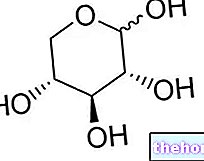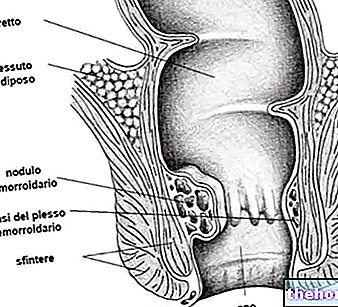Generality
A perianal abscess is a collection of pus located near the anus or in the terminal portion of the rectum. This condition manifests itself as a painful swelling, covered with tight and intensely red skin.

Certain pathological conditions, such as diverticulitis, colitis, or other inflammatory bowel diseases, can make the development of a perianal abscess more likely.
Other predisposing factors are trauma, changes in stool consistency and complications from surgery on hemorrhoids or fissures.
Observation, palpation of the anus and surrounding tissues, and rectal exploration are usually sufficient to diagnose perianal abscess. Surgical therapy is required to determine the patient's recovery.
What's this
A perianal abscess represents the acute phase of an infection that originates from the microscopic glands, secreting mucus, present between the anal sphincters (ie between the muscles surrounding the anus).
The predisposing factors are varied and include diarrhea and, conversely, the passage of very hard stools. Other conditions that favor perianal abscess are certain chronic intestinal diseases, such as Crohn's disease and ulcerative colitis, in addition to the sequelae of interventions on hemorrhoids and fissures.Added to this is the fact that the anal canal and rectum are anatomical points at high risk of infection, due to the persistent humidity and the numerous organisms present in the stool.
The perianal abscess is a very painful condition, which can be accompanied by fever and generalized malaise. The collection of pus, placed immediately in the vicinity of the anus, can escape from the skin that contains it, spontaneously or after a surgical incision.
Causes
The perianal abscess is the result of inflammation, which will result in the collection of pus. The origin of this inflammatory process is the non-specific infection of one of the glands of Hermann and Desfosses, located inside the anal canal and in the terminal portion of the rectal ampulla.
These small anatomical structures are absolutely invisible to the naked eye; their function consists in facilitating the passage of faeces, secreting a lubricating mucus in the anal crypts (small depressions in the shape of a swallow's nest that are arranged in the region of the anus in a circular way).
Infection is caused by the penetration of bacteria or foreign material into the gland. For ease of exposure, in fact, this glandular structure has a bottle shape, with the neck facing the lumen of the anal canal. The obstruction of the duct of the gland causes stasis, infection and the formation of an abscess.
The pathological process underlying the perineal abscess can be favored by various factors:
- Local trauma (penetration of foreign bodies, anal eroticism, incorrect execution of enemas, hard fecal bolus, etc.);
- Presence of solid residues in the fecal material wedged in the glandular orifice;
- Alteration of the pH or consistency of the stool (eg diarrheal syndromes, constipation, etc.);
- Anal ulcers;
- Proctiti;
- Rectal cancer
- Inflammatory bowel diseases, such as Crohn's disease, diverticulitis and ulcerative colitis;
- Surgical interventions (episiotomy, haemorrhoidectomy, prostatectomy, etc.);
- Impaired immune system
- Actinomycosis and tuberculosis;
- Sexually transmitted diseases (e.g. chlamydia, syphilis and venereal lymphogranuloma).
The infection spreads into the tissues using the glandular channels and reaches the perianal skin where, due to the resistance opposed by the same, it stops. Immediately under the skin, therefore, all the material produced by the inflammatory process accumulates, then evolving into pus.
Symptoms and complications
Typical symptoms associated with perianal abscess are:
- Localized pain, intense and throbbing, both around the anus and along the rectum;
- Swelling in the vicinity of the anus;
- Redness of the skin, if the abscess is located near the surface.
These manifestations identify the marked inflammatory character of the perianal abscess.
The perianal abscess does not immediately manifest itself as a swelling, as the collection of pus represents the final evolution of the clinical picture. Usually, the swelling is felt by the patient in the intermediate and final stages of the disease process and is sometimes mistaken for a hemorrhoidal thrombosis.
The pain localized in the perianal area tends to progressively increase in a manner directly proportional to the evolution of the abscess, and exacerbates on palpation and during defecation. This symptom can take on a continuous character, so much so as to induce the assumption of a posture that can somehow alleviate the disorder.
In some cases, there may be no obvious signs, but digital examination may reveal a hard and very painful swelling in the rectal wall.
In the presence of a perianal abscess, general symptoms occur quite frequently, such as:
- Malaise;
- Fever;
- Accelerated pulsations.
The infection progressively spreads to the surrounding tissues, forming a channel that connects the anal gland (from which the abscess originates) with the skin of the perianal region, as the pus seeks a way out towards the outside.
The leakage of the purulent material is immediately perceived by the patient as a relief of the symptoms accused up to that moment, since the tension of the tissues that contained the infection is reduced. If the laceration of an abscess creates a false passage through the intestine and the skin around the anus, a perianal fistula may result.
When the external orifice of the canal closes (apparent healing), however, a recurrent abscess may develop and the fever and pain will reappear, revealing the recurrence of the purulent collection.
The abscess and the perianal fistula represent two different stages of the same pathology:
- The abscess represents the acute phase of an infection originating from the mucus-secreting glands present in the anal canal;
- The fistula represents a "chronic evolution of this process.
Perianal fistulas cause irritation of the skin around the anus and itching, which tend to become accentuated during defecation and are typically accompanied by continuous and malodorous serum-purulent secretions from a small hole located on the skin next to the anus. In some cases, fatigue, fever, and pelvic pain may be present.
Diagnosis
The diagnosis is made following a visit with rectal examination.
The perianal abscess can be more or less deep and pass through the anal muscles suitable for continence (sphincters), which must be spared during surgical therapy. To better define the relationship of the inflammatory process with the surrounding muscles, the doctor can use tests , such as transanal ultrasound and magnetic resonance imaging.
If you have a perianal abscess, your white blood cell count is usually high.
When a painful anal swelling associated with fever is felt, it is important to perform a proctological examination.
If diagnosed in the right time, the abscess can be treated correctly and in a timely manner.
Therapy
In general, the treatment of any abscess essentially consists of incising and draining the collection of pus.
The operation represents a surgical emergency and must be performed as soon as possible to prevent the infection from spreading to other sites.
It should be emphasized that the "incision must" always be performed when the infection has "organized" into a purulent collection, therefore when this is appreciable.
After treatment, resolution of acute symptoms is immediate and tests return to normal.
The more superficial abscesses drain under local anesthesia and sedation, while the more complex ones will be treated under spinal or general anesthesia.
Generally, after the operation, a drain is left in place for a period of time that varies according to the case. The dressings will then be replaced on a daily basis, then weekly, until the wound is healed.
The administration of antibiotics does not resolve the abscess, but only tends to make it chronic.




























